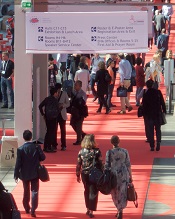Platelet transfusion deemed ‘harmful’ in patient group

Congress of the European
Hematology Association
COPENHAGEN—Results of the phase 3 PATCH trial suggest that platelet transfusions are not beneficial and can actually cause harm in patients with intracerebral hemorrhage (ICH) associated with antiplatelet therapy.
The study showed that the odds of death or dependence at 3 months were significantly higher among patients who received a platelet transfusion plus standard care than among patients who received standard care alone.
Patients who received a platelet transfusion also had a higher incidence of severe adverse events (SAEs) during hospital admission.
“PATCH shows that platelet transfusion seems harmful for patients with antiplatelet-associated ICH,” said study investigator Maria Koopman, PhD, of Sanquin Bloodbank in Amsterdam, The Netherlands.
“Pending further evidence, we think that platelet transfusions should not be used in this patient group.”
Dr Koopman presented results of the PATCH trial at the 21st Congress of the European Hematology Association (abstract LB2234). The study was also recently published in The Lancet.
Dr Koopman noted that, worldwide, there are 2 million cases of ICH each year, and more than 25% of these patients are taking antiplatelet therapy at ICH onset.
She and her colleagues theorized that because antiplatelet therapy can lead to hematoma growth and poor outcomes, platelet transfusions might modify the effect of antiplatelet therapy and improve patient outcomes.
To test this theory, the team studied ICH patients treated at 60 hospitals in The Netherlands, Scotland, and France.
Patients and treatment
The study included patients with spontaneous supratentorial ICH who were 18 years of age or older, had been using antiplatelet therapy for at least 7 days preceding ICH, and had a Glasgow Coma Scale score of 8 or higher.
The patients were randomized 1:1 to receive either standard care alone or standard care plus a platelet transfusion within 6 hours of the start of symptoms and within 90 minutes of diagnostic brain imaging.
In all, 190 patients were randomized—97 to the transfusion arm and 93 to the standard care arm. Ultimately, 93 patients actually received a platelet transfusion, and 91 received standard care alone.
Patient characteristics were generally balanced between the treatment arms. The mean age was 74.2 in the transfusion arm and 73.5 in the standard care arm. Median scores on the Glasgow Coma Scale were 14 (range, 13-15) and 15 (range, 13-15), respectively.
Comorbidities included cerebral infarction (38.4% and 40%, respectively), hypertension (72.3% and 72.8%, respectively), diabetes (15.5% and 18.9%, respectively), myocardial infarction (23.6% and 24.4%, respectively), and peripheral artery disease (16.5% and 4.4%, respectively).
Antiplatelet therapy consisted of a cyclooxygenase (COX) inhibitor (73.2% and 83.9%, respectively), a COX inhibitor plus dipyridamole (18.6% and 14%, respectively), an adenosine diphosphate (ADP) receptor inhibitor (4.1% and 1.1%, respectively), and an ADP inhibitor plus a COX inhibitor (3.1% and 1.1%, respectively).
Efficacy
The study’s primary outcome was a shift toward death or dependence, rated on the modified Rankin Scale (mRS), at 3 months after ICH, adjusted for hospital, antiplatelet therapy, and ICH score. The primary analysis was done in the intention-to-treat population (n=97 in the transfusion arm and 93 in the standard care arm).
The investigators found the odds of death or dependence at 3 months were higher in the platelet transfusion arm than the standard care arm. The adjusted common odds ratio (OR) was 2.05 (95% CI 1.18-3.56; P=0.0114).
The study’s secondary endpoints were survival at 3 months, poor outcome (dichotomous mRS 4-6 or 3-6) at 3 months, and hematoma growth on imaging within 24 hours.
The survival rate was lower in the transfusion arm than the standard care arm, although the difference was not statistically significant—68% and 77.4%, respectively (OR=0.62; 95% CI, 0.33-1.19; P=0.15).






